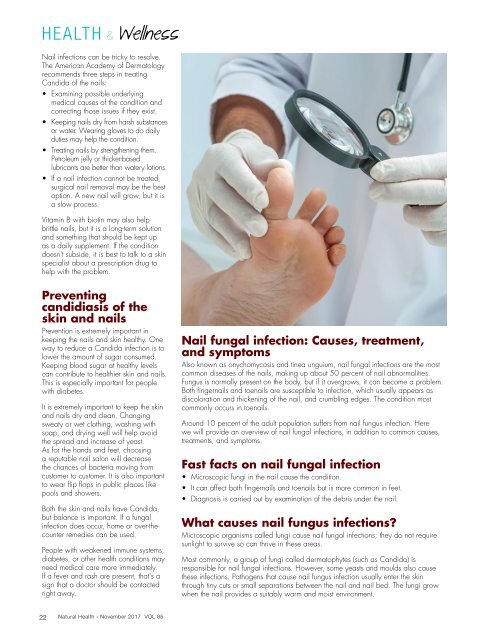Natural Health November 2018
Create successful ePaper yourself
Turn your PDF publications into a flip-book with our unique Google optimized e-Paper software.
HEALTH & Wellness<br />
Nail infections can be tricky to resolve.<br />
The American Academy of Dermatology<br />
recommends three steps in treating<br />
Candida of the nails:<br />
• Examining possible underlying<br />
medical causes of the condition and<br />
correcting those issues if they exist.<br />
• Keeping nails dry from harsh substances<br />
or water. Wearing gloves to do daily<br />
duties may help the condition.<br />
• Treating nails by strengthening them.<br />
Petroleum jelly or thicker-based<br />
lubricants are better than watery lotions.<br />
• If a nail infection cannot be treated,<br />
surgical nail removal may be the best<br />
option. A new nail will grow, but it is<br />
a slow process.<br />
Vitamin B with biotin may also help<br />
brittle nails, but it is a long-term solution<br />
and something that should be kept up<br />
as a daily supplement. If the condition<br />
doesn't subside, it is best to talk to a skin<br />
specialist about a prescription drug to<br />
help with the problem.<br />
Preventing<br />
candidiasis of the<br />
skin and nails<br />
Prevention is extremely important in<br />
keeping the nails and skin healthy. One<br />
way to reduce a Candida infection is to<br />
lower the amount of sugar consumed.<br />
Keeping blood sugar at healthy levels<br />
can contribute to healthier skin and nails.<br />
This is especially important for people<br />
with diabetes.<br />
It is extremely important to keep the skin<br />
and nails dry and clean. Changing<br />
sweaty or wet clothing, washing with<br />
soap, and drying well will help avoid<br />
the spread and increase of yeast.<br />
As for the hands and feet, choosing<br />
a reputable nail salon will decrease<br />
the chances of bacteria moving from<br />
customer to customer. It is also important<br />
to wear flip flops in public places like<br />
pools and showers.<br />
Both the skin and nails have Candida,<br />
but balance is important. If a fungal<br />
infection does occur, home or over-thecounter<br />
remedies can be used.<br />
People with weakened immune systems,<br />
diabetes, or other health conditions may<br />
need medical care more immediately.<br />
If a fever and rash are present, that's a<br />
sign that a doctor should be contacted<br />
right away.<br />
Nail fungal infection: Causes, treatment,<br />
and symptoms<br />
Also known as onychomycosis and tinea unguium, nail fungal infections are the most<br />
common diseases of the nails, making up about 50 percent of nail abnormalities.<br />
Fungus is normally present on the body, but if it overgrows, it can become a problem.<br />
Both fingernails and toenails are susceptible to infection, which usually appears as<br />
discoloration and thickening of the nail, and crumbling edges. The condition most<br />
commonly occurs in toenails.<br />
Around 10 percent of the adult population suffers from nail fungus infection. Here<br />
we will provide an overview of nail fungal infections, in addition to common causes,<br />
treatments, and symptoms.<br />
Fast facts on nail fungal infection<br />
• Microscopic fungi in the nail cause the condition.<br />
• It can affect both fingernails and toenails but is more common in feet.<br />
• Diagnosis is carried out by examination of the debris under the nail.<br />
What causes nail fungus infections?<br />
Microscopic organisms called fungi cause nail fungal infections; they do not require<br />
sunlight to survive so can thrive in these areas.<br />
Most commonly, a group of fungi called dermatophytes (such as Candida) is<br />
responsible for nail fungal infections. However, some yeasts and moulds also cause<br />
these infections. Pathogens that cause nail fungus infection usually enter the skin<br />
through tiny cuts or small separations between the nail and nail bed. The fungi grow<br />
when the nail provides a suitably warm and moist environment.<br />
22 <strong>Natural</strong> <strong>Health</strong> * <strong>November</strong> 2017 VOL 85

















